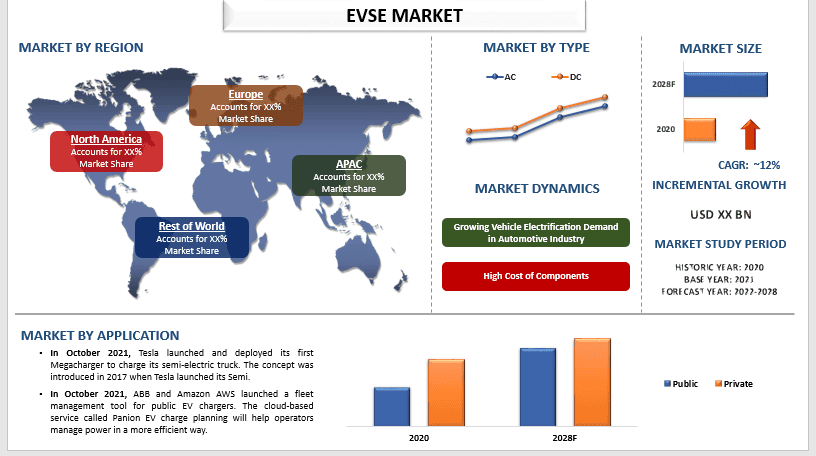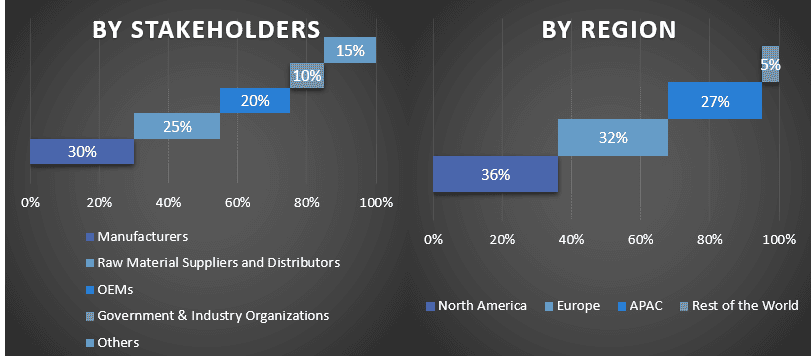- Home
- Chi siamo
- Settore
- Servizi
- Lettura
- Contattaci
Mercato delle apparecchiature per l'alimentazione di veicoli elettrici (EVSE): Analisi attuale e previsioni (2022-2028)
Enfasi sul Tipo (Corrente Alternata (AC) {Livello 1 e Livello 2} e Corrente Continua (DC) {CHAdeMO, Combined Charging System (CCS), GB/T e Altri}); Applicazione (Pubblica e Privata); Regione/Paese

RICHIEDI UN PDF DI ESEMPIO GRATUITO
L'apparecchiatura di alimentazione per veicoli elettrici (EVSE) è l'unità di base dell'infrastruttura di ricarica dei veicoli elettrici. L'EVSE accede all'energia dalla rete elettrica locale e utilizza un sistema di controllo e un collegamento cablato per caricare in sicurezza i veicoli elettrici.
Si prevede che il mercato globale delle apparecchiature di alimentazione per veicoli elettrici (EVSE) registrerà un significativo CAGR di circa il 12% durante il periodo di previsione a causa della crescente domanda di veicoli elettrici e dei crescenti incentivi e sussidi da parte dei governi di tutto il mondo per l'adozione di massa e la produzione nazionale di veicoli elettrici. Ad esempio, il National Electric Mobility Mission Plan (NEMMP) e il Faster Adoption and Manufacturing of Hybrid & Electric Vehicles in India (FAME I e II) hanno contribuito a creare l'interesse iniziale e l'esposizione per la mobilità elettrica. Ad esempio, nella seconda fase del FAME, il governo ha annunciato uno stanziamento di 1,4 miliardi di dollari fino al 2022. Pertanto, si prevede che tali iniziative governative guideranno la crescita dei veicoli elettrici e del mercato delle apparecchiature di alimentazione per veicoli elettrici.
Alcuni dei principali operatori che operano nel mercato includono Leviton Manufacturing Co. Inc., Webasto Charging Systems Inc., Chargemaster Ltd., ChargePoint Inc., Efacec Electric Mobility S.A., Blink Charging Co., Schneider Electric SE, ABB Ltd., Tesla Inc. e BYD Co. Ltd.
Approfondimenti presentati nel rapporto
"Tra i tipi, la corrente continua (DC) assisterà a una crescita significativa durante il periodo di previsione"
In base al tipo, il mercato è diviso in corrente alternata (AC) e corrente continua (DC). La categoria DC assisterà al CAGR più alto durante il periodo di previsione. I sistemi di ricarica rapida per veicoli elettrici possono variare da 23KW a più di 200KW. Questo sistema di ricarica si trova principalmente nell'area pubblica e carica il veicolo più velocemente dei normali caricabatterie. Inoltre, un caricabatterie rapido DC non richiede un convertitore integrato all'interno del veicolo per la conversione di corrente. La crescente elettrificazione dei veicoli e l'ansia da autonomia tra gli utenti di veicoli elettrici stanno portando sia gli attori pubblici che privati a installare più caricabatterie rapidi DC in luoghi pubblici e commerciali.
"Tra le applicazioni, si prevede che la categoria pubblica registrerà un tasso di crescita più elevato durante il periodo di previsione"
In base all'applicazione, il mercato è diviso in pubblico e privato. Si prevede che la categoria pubblica registrerà un tasso di crescita più elevato durante il periodo di previsione a causa dell'implementazione di politiche volte ad aumentare l'uso di veicoli elettrici fornendo sussidi e tasse ridotte in tutto il mondo, in particolare in paesi come India e Cina. Inoltre, la disponibilità di stazioni di ricarica pubbliche per veicoli elettrici è fondamentale per l'acquisto di veicoli elettrici. Quando si sceglie un veicolo elettrico, la disponibilità di stazioni di ricarica rapida e di ricarica pubblica sono considerazioni importanti. Pertanto, i governi di queste economie emergenti hanno riconosciuto il potenziale di crescita del mercato globale delle stazioni di ricarica per veicoli elettrici. Questo è un fattore importante responsabile della crescita della categoria.
"La regione APAC deterrà una quota significativa nel mercato"
Nel 2020, la regione APAC si è aggiudicata la quota di mercato maggiore del mercato globale e si prevede che crescerà con un CAGR considerevole durante il periodo di previsione a causa della crescente popolazione attiva e dell'espansione della popolazione della classe media, creando così domanda di veicoli elettrici di nuova generazione. Inoltre, la Cina è uno dei maggiori produttori e consumatori di veicoli elettrici al mondo. La domanda interna è supportata dagli obiettivi di vendita nazionali, dalle leggi favorevoli e dagli obiettivi municipali di qualità dell'aria.
Inoltre, iniziative e programmi governativi di supporto per promuovere l'adozione di soluzioni di mobilità sostenibile per ridurre il livello di inquinamento dei veicoli promuoveranno l'espansione del mercato. Inoltre, i principali OEM lanciano continuamente veicoli elettrici premium e investono nell'infrastruttura di ricarica per veicoli elettrici per supportare l'adozione di veicoli elettrici. Ad esempio, nel marzo 2022, BYD e Shell hanno stipulato un accordo di cooperazione strategica globale per l'infrastruttura di ricarica. Ciò inizierà in Cina e in Europa e successivamente sarà ampliato a livello globale.
Motivi per acquistare questo rapporto:
- Lo studio include l'analisi della dimensione del mercato e delle previsioni convalidate da esperti chiave del settore autenticati.
- Il rapporto presenta una rapida panoramica della performance complessiva del settore a colpo d'occhio.
- Il rapporto copre un'analisi approfondita dei principali concorrenti del settore con un focus primario sui principali dati finanziari aziendali, sul portafoglio prodotti, sulle strategie di espansione e sugli sviluppi recenti.
- Esame dettagliato dei driver, dei vincoli, delle tendenze chiave e delle opportunità prevalenti nel settore.
- Lo studio copre in modo completo il mercato attraverso diversi segmenti.
- Analisi approfondita a livello regionale del settore.
Opzioni di personalizzazione:
Il mercato globale EVSE può essere ulteriormente personalizzato in base alle esigenze o a qualsiasi altro segmento di mercato. Inoltre, UMI comprende che potresti avere le tue esigenze aziendali, quindi sentiti libero di metterti in contatto con noi per ottenere un rapporto che si adatti completamente alle tue esigenze.
Indice
Metodologia di ricerca per l'analisi del mercato delle apparecchiature di alimentazione per veicoli elettrici (EVSE) (2022-2028)
L'analisi del mercato storico, la stima del mercato attuale e la previsione del mercato futuro del mercato globale EVSE sono state le tre principali fasi intraprese per creare e analizzare l'adozione di un EVSE nelle principali regioni a livello globale. È stata condotta un'esauriente ricerca secondaria per raccogliere i dati storici del mercato e stimare le dimensioni del mercato attuale. In secondo luogo, per convalidare queste informazioni, sono state prese in considerazione numerose scoperte e ipotesi. Inoltre, sono state condotte anche approfondite interviste primarie con esperti del settore lungo tutta la catena del valore del mercato globale EVSE. Dopo l'assunzione e la convalida dei dati di mercato attraverso interviste primarie, abbiamo impiegato un approccio top-down/bottom-up per prevedere le dimensioni complete del mercato. Successivamente, sono stati adottati metodi di suddivisione del mercato e di triangolazione dei dati per stimare e analizzare le dimensioni del mercato dei segmenti e dei sottosegmenti del settore di riferimento. La metodologia dettagliata è spiegata di seguito:
Richiedi maggiori dettagli sulla metodologia di ricerca
Analisi delle dimensioni storiche del mercato
Fase 1: Studio approfondito delle fonti secondarie:
È stato condotto uno studio secondario dettagliato per ottenere le dimensioni storiche del mercato EVSE attraverso fonti interne aziendali come relazioni annuali e bilanci, presentazioni sulle prestazioni, comunicati stampa, ecc., e fonti esterne tra cui riviste, notizie e articoli, pubblicazioni governative, pubblicazioni della concorrenza, relazioni di settore, database di terze parti e altre pubblicazioni credibili.
Fase 2: Segmentazione del mercato:
Dopo aver ottenuto le dimensioni storiche del mercato EVSE, abbiamo condotto un'analisi secondaria dettagliata per raccogliere informazioni storiche sul mercato e condividere diversi segmenti e sottosegmenti per le principali regioni. I principali segmenti inclusi nel report sono tipo e applicazione. Sono state inoltre condotte analisi a livello di paese per valutare l'adozione complessiva di modelli di test in quella regione.
Fase 3: Analisi dei fattori:
Dopo aver acquisito le dimensioni storiche del mercato di diversi segmenti e sottosegmenti, abbiamo condotto un'analisi dei fattori dettagliata per stimare le dimensioni attuali del mercato EVSE. Inoltre, abbiamo condotto un'analisi dei fattori utilizzando variabili dipendenti e indipendenti come i vari tipi e applicazioni di EVSE. È stata condotta un'analisi approfondita degli scenari di domanda e offerta considerando le principali partnership, fusioni e acquisizioni, espansioni aziendali e lanci di prodotti nel settore del mercato EVSE in tutto il mondo.
RICHIESTA DI PERSONALIZZAZIONE
Stima e previsione delle dimensioni attuali del mercato
Dimensionamento attuale del mercato: Sulla base delle informazioni utili ricavate dai 3 passaggi precedenti, siamo giunti alle dimensioni attuali del mercato, ai principali attori del mercato globale EVSE e alle quote di mercato dei segmenti. Tutte le quote percentuali richieste e le suddivisioni del mercato sono state determinate utilizzando l'approccio secondario sopra menzionato e sono state verificate tramite interviste primarie.
Stima e previsione: Per la stima e la previsione del mercato, sono stati assegnati pesi diversi a fattori quali driver e tendenze, vincoli e opportunità disponibili per le parti interessate. Dopo aver analizzato questi fattori, sono state applicate tecniche di previsione pertinenti, ovvero l'approccio top-down/bottom-up, per giungere alla previsione di mercato per il 2027 per diversi segmenti e sottosegmenti nei principali mercati a livello globale. La metodologia di ricerca adottata per stimare le dimensioni del mercato comprende:
- Le dimensioni del mercato del settore, in termini di entrate (USD) e il tasso di adozione del mercato EVSE nei principali mercati nazionali
- Tutte le quote percentuali, le suddivisioni e le ripartizioni dei segmenti e sottosegmenti di mercato
- I principali attori nel mercato globale EVSE in termini di prodotti offerti. Inoltre, le strategie di crescita adottate da questi attori per competere nel mercato in rapida crescita
Convalida delle dimensioni e della quota di mercato
Ricerca primaria: Sono state condotte interviste approfondite con i Key Opinion Leader (KOL) tra cui dirigenti di alto livello (CXO/VP, responsabile vendite, responsabile marketing, responsabile operativo, responsabile regionale, responsabile nazionale, ecc.) nelle principali regioni. I risultati della ricerca primaria sono stati quindi riassunti e sono state eseguite analisi statistiche per dimostrare l'ipotesi dichiarata. L'input della ricerca primaria è stato consolidato con i risultati secondari, trasformando le informazioni in informazioni utili.
Suddivisione dei partecipanti primari nelle diverse regioni

Ingegneria del mercato
La tecnica di triangolazione dei dati è stata impiegata per completare la stima complessiva del mercato e per giungere a numeri statistici precisi per ciascun segmento e sottosegmento del mercato globale EVSE. I dati sono stati suddivisi in diversi segmenti e sottosegmenti dopo aver studiato vari parametri e tendenze nelle aree del tipo e dell'applicazione nel mercato globale EVSE.
L'obiettivo principale dello studio sul mercato globale EVSE
Le tendenze di mercato attuali e future del mercato globale EVSE sono state individuate nello studio. Gli investitori possono ottenere informazioni strategiche per basare la loro discrezione per gli investimenti sull'analisi qualitativa e quantitativa eseguita nello studio. Le tendenze del mercato attuali e future hanno determinato l'attrattiva complessiva del mercato a livello regionale, fornendo una piattaforma per il partecipante industriale per sfruttare il mercato non sfruttato per beneficiare di un vantaggio per i primi arrivati. Altri obiettivi quantitativi degli studi includono:
- Analizzare le dimensioni del mercato attuali e previste del mercato EVSE in termini di valore (USD). Inoltre, analizzare le dimensioni del mercato attuali e previste di diversi segmenti e sottosegmenti
- I segmenti nello studio includono aree di analisi del tipo e dell'applicazione del quadro normativo per l'industria EVSE.
- Analizzare la catena del valore coinvolta con la presenza di vari intermediari, insieme all'analisi dei comportamenti dei clienti e dei concorrenti del settore.
- Analizzare le dimensioni del mercato attuali e previste del mercato EVSE per la regione principale.
- I principali paesi delle regioni studiate nel report includono Asia Pacifico, Europa, Nord America e il resto del mondo.
- Profili aziendali del mercato EVSE e le strategie di crescita adottate dagli operatori di mercato per sostenersi nel mercato in rapida crescita
- Analisi approfondita a livello regionale del settore
Correlati Report
I clienti che hanno acquistato questo articolo hanno acquistato anche










